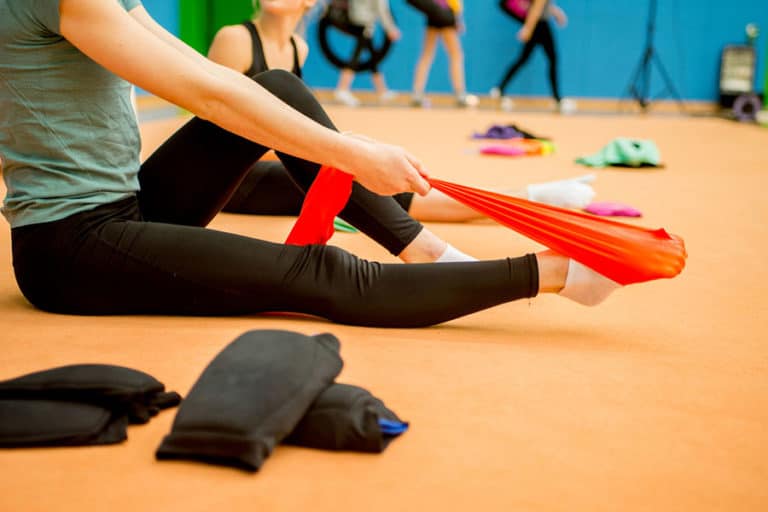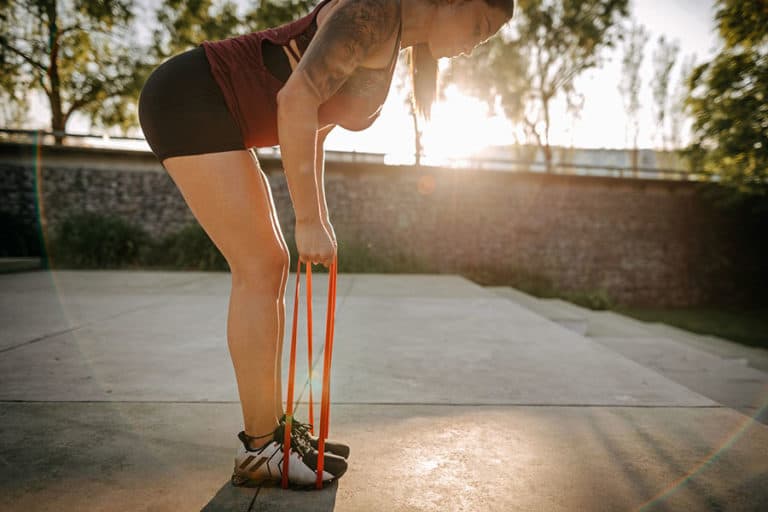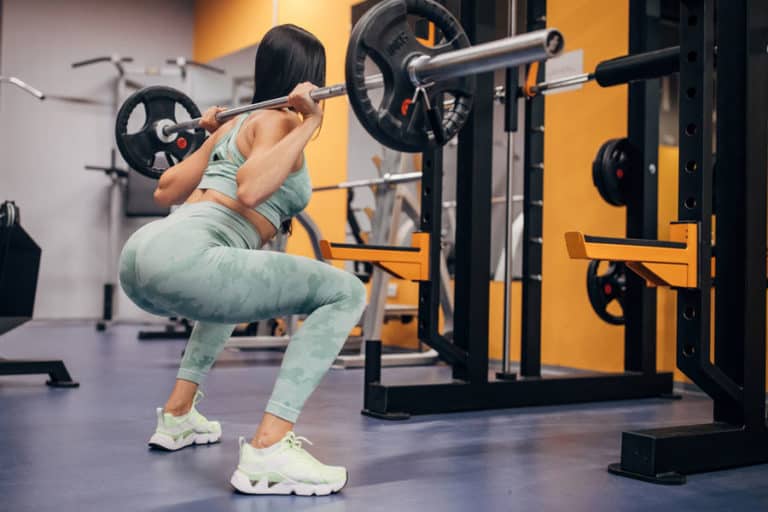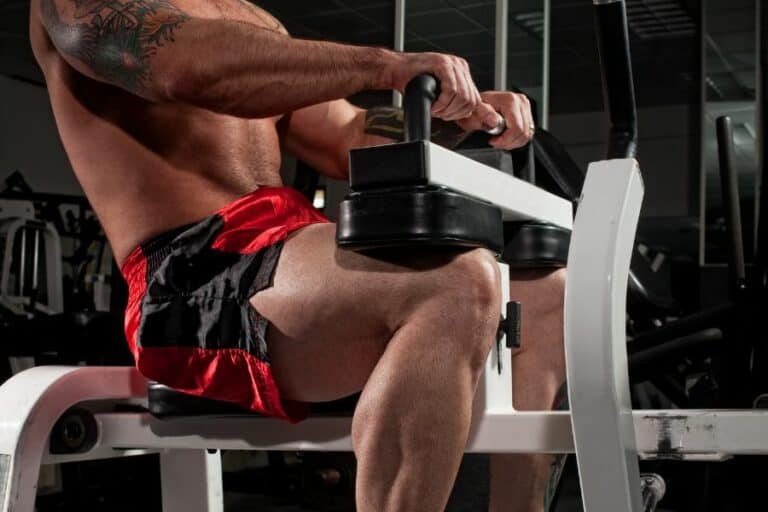Squats for Glutes – Technique, Variations, and Safety Tips

Squats for Glutes | Role of Glutes | Safety Tips
Squats are the go-to exercises for lower body strength in general and for glute muscle toning in particular. However, despite the gluteal muscles playing such an important role in the execution of the squat movements, squat workouts generally tend to remain quad-dominant exercises.
A little more focus on the squat form, depth, and movement of the hips can help you correct this imbalance and achieve more toned and lifted glutes.
7 best squats for glutes
To activate and target the glute muscles, you need to select specific squat variations whose squat depth and stance width allow you to move through a greater range of motion at the hips. Research has shown that the greater the range of motion (ROM) [1]ResearchGate: A Brief Review on the Effects of the Squat Exercise on Lower-Limb Muscle Hypertrophy your hips go through while squatting, the more your glutes will be activated.
Here are 7 of the best squat variations to try out for more toned and strong glutes:
1. Sumo squat
Target muscles: Glutes, quads, hamstrings, hip flexors, calves, adductors, core, and back
How to do
- Stand with your feet wider than shoulder-width apart.
- Keep the arms bent, elbows pointing downwards, wrists held in a clasp in front, and your toes turned out.
- Lower yourself down by bending your knees and hips, keeping your back straight.
- Stop when your thighs are parallel to the ground, and then slowly raise yourself back up to the starting position.
Summary: The sumo squat involves squatting with a wider-than-usual stance. This allows for higher levels of hip extension and external rotation. Since the glute muscles play an important role in hip extension and external rotation movements, they are activated to a greater extent in the sumo squat than in other squat variations.
2. Bulgarian split squat
Target muscles: Glutes, quads, hamstrings, calf muscles, biceps femoris, and core muscles
How to do
- Place a bench behind you, extend one leg back and place the top of your foot on the bench.
- Keeping your chest up and your core engaged, lower yourself down by bending your front knee.
- Stop when your front thigh is parallel to the ground, and then press through your heel to return to the starting position.
Summary: The bulgarian split squat is a rear leg elevated squat (RLESS) [2]ResearchGate: Muscle Activity in Single- vs. Double-Leg Squats variation has been observed to produce greater levels of activity in the glute muscle. Plus, the added stability challenge of having to balance on one leg also works the muscles of the core to a greater extent.
3. Pulse squat
Target muscles: Glutes, quads, hamstrings, and core
How to do
- Start by standing with your feet shoulder-width apart.
- Extend your arms straight in front of you.
- Lower yourself down by bending your knees and lowering the hips while keeping your spine erect throughout.
- Stop when your thighs are parallel to the ground.
- Pulse up and down for 30 seconds.
Summary: While pulse squat seemingly lacks the squat depth required for glute muscle activation, it can still be great for your glutes. This is because the pulsing movement adds a good amount of time under tension (TUT) for the muscles to work, which can lead to increased muscle growth.
4. Goblet squat
Target muscles: Glutes, quads, adductors, hamstrings, biceps, traps, and lats
How to do
- Stand with your feet shoulder-width apart and toes pointed slightly outward.
- Hold a kettlebell by its horns with both hands at chest level.
- Keep your core engaged and spine neutral.
- Lower your hips until the hips descend past the knees.
- Push through your heels and return to the starting position.
Summary: The goblet squat is a great beginner-friendly variation that can be done with minimal equipment. The added weight and the depth of squat in this variation provide a good amount of challenge to the muscles of the lower body, especially the glutes.
5. Jump squat
Target muscles: Glutes, quads, calves, and core
How to do
- Start with your feet hip-width apart and your hands at your sides.
- Keeping your back straight, slowly lower your hips down.
- Stop when your thighs are parallel to the ground, and then jump up into the air.
- Land softly on your feet and lower yourself back into the squat position.
Summary: The jump squat is a plyometric exercise, which means it involves explosive movements. This variation is great for not only toning your glutes but also for improving your cardiovascular endurance.
6. Back squat
Target muscles: Glutes, quads, adductors, calves, hamstrings, lower back muscles, and core muscles
How to do
- Start by standing in front of a barbell placed on a squat rack.
- Adjust the weight and height of the barbell.
- Get inside the rack and under the barbell. Now, grip the bar with your hands placed a little away from your shoulders.
- Keep your feet shoulder-width apart and slowly unrack the barbell.
- Step back from the rack along with the barbell.
- Push your hips back, bend your knees and squat down until your thighs are parallel to the floor.
- Push through your heels and return back to the standing position.
Summary: Back squats are a challenging, weighted variation of squats. They work all your gluteal muscles during the descending phase [3]National Library of Medicine: The Activation of Gluteal, Thigh, and Lower Back Muscles in Different Squat Variations Performed by Competitive Bodybuilders: Implications for Resistance Training. Additionally, back squats work nearly all the muscles of your lower body, and several others in the upper arm and back region. This makes them a great exercise for overall strength and muscle development.
7. Squats with resistance bands
Target muscles: Glutes, quads, adductors, hamstrings, and core
How to do
- Take a resistance band and place it such that it rests around your thighs and stand with your feet shoulder-width apart.
- Brace your core, maintain a neutral spine and lower your hips until your thighs are parallel to the ground.
- Push through your heels and drive your hips upwards to return to the starting position.
Summary: A 2020 study [4]PubMed: Barbell back squat: how do resistance bands affect muscle activation and knee kinematics? has observed that the use of a resistance band when squatting significantly increases gluteus maximus activity. So, if you are new to squat workouts but would like to focus on your glutes, this variation is ideal for you.
Role of glutes in a squat workout
The glute muscles [5]National Library of Medicine: Anatomy, Bony Pelvis and Lower Limb, Gluteus Maximus Muscle are a group of three muscles in the posterior region: the gluteus maximus, gluteus medius, and gluteus minimus. Together, these comprise the largest and strongest muscles in the body. They are responsible for most of the movement in the hip region.
When it comes to squatting, the glutes play a vital role. The main muscle group worked during a squat is the quads. However, the glutes also play an important role in stabilizing the body and providing power to drive the movement.
Glute muscles are particularly responsible for the external rotation and extension of the hips. This means that they are central to the downward movement of a squat.
Tips to activate the glutes
Agility and strength in the glute muscles can be important for more reasons than mere physical aesthetics. Glute muscles are important for strength, stability, and movement in the hip region. Additionally, strong glutes can help prevent lower back pain and knee injuries.
Here are a few tips to help you better activate your glutes during squat workouts
- Squeeze your glutes at the top of the movement.
- Glutes are central to your hip movement. Focus on the position and movement of your hips, especially during the descending phase.
- Turn your toes outward during the squats.
- Rising through your heels will ensure better activation of glute muscles.
- Try glute activation warm-up techniques like foam rolling.
- Get enough rest and recovery between workouts.
- Ensure that your diet is rich in protein to facilitate muscle growth.
Do squats really work your glutes?
Yes, squats are an excellent exercise for working your glutes. They engage the glute muscles by using them to extend the hips and stand up from a squatting position.
What happens if you do squats everyday?
While doing squats daily can help to build strength and improve your overall fitness level, it can also lead to overuse injuries such as strain or inflammation of the muscles and joints involved in the exercise.
Additionally, if you don’t allow for adequate rest and recovery time, you may experience burnout or decreased performance.
To avoid these risks, it’s best to vary your workout routine and incorporate rest days to allow your muscles to recover and prevent overuse injuries..
How do you activate glutes in squats?
To further focus on the glutes, you can try glute-focused squat variations such as sumo squats or Bulgarian split squats, or add resistance with barbells or resistance bands..
To activate glutes in squats, focus on driving through your heels, keeping your knees in line with your toes, and engaging your glutes at the top of the movement.
By choosing squats that target the glutes and using proper squat form, you can effectively build and tone your glute muscles
Conclusion
The glutes are the largest and strongest muscles in the body. They stabilize the body and provide power to drive the squat movement. If you are specifically concerned about your squat workout not working your glutes enough, try the variations and tips given above.
Alternatively, you could seek the guidance of a personal fitness trainer who will help you formulate a squat workout plan according to your requirement.
FAQs
Here are a few frequently asked questions regarding squats that target glutes:
How many squats should I do for glutes?
It depends on your fitness level and goals, but generally, 3 sets of 8-12 reps with proper form can be effective for building and toning glutes.
What is the fastest way to grow your glutes?
The fastest way to grow your glutes is through a combination of strength training exercises such as squats, lunges, and deadlifts, proper nutrition, and adequate rest and recovery.
References
| ↑1 | ResearchGate: A Brief Review on the Effects of the Squat Exercise on Lower-Limb Muscle Hypertrophy |
|---|---|
| ↑2 | ResearchGate: Muscle Activity in Single- vs. Double-Leg Squats |
| ↑3 | National Library of Medicine: The Activation of Gluteal, Thigh, and Lower Back Muscles in Different Squat Variations Performed by Competitive Bodybuilders: Implications for Resistance Training |
| ↑4 | PubMed: Barbell back squat: how do resistance bands affect muscle activation and knee kinematics? |
| ↑5 | National Library of Medicine: Anatomy, Bony Pelvis and Lower Limb, Gluteus Maximus Muscle |







